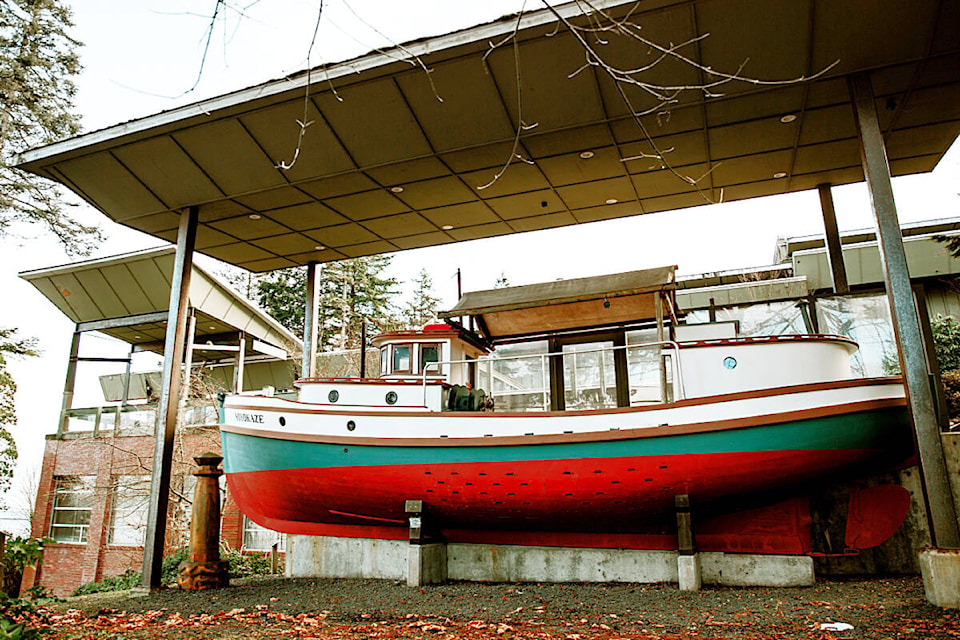The value of an object lies in the stories it enables us to share.
These stories often revolve around the people who used, cared for, and protected the object. Without it, these stories can easily fade into obscurity.
The story of the Japanese cod fishing boat Soyokaze and its owners, the Matsunaga family, is a prime example of the importance of preserving these stories.
The story of Mr. Shigekazu Matsunaga begins in 1908 in Steveston, B.C. where he was born. At the young age of five, his parents sent Shigekazu back to Japan to receive a formal education. He returned to Canada at 17 and with hard work and perseverance, purchased his first boat and settled in Quathiaski Cove on Quadra Island.
Five other Japanese-Canadian families were already living in Quathiaski Cove at the time, and they helped Shigekazu make a vital connection to a Japanese lingcod buyer, securing a steady market for his daily catch. With his business thriving, Shigekazu returned to Japan in search of a wife to join him on Quadra Island. There, he met and married Toshika, who had attended the same school as him, albeit a few years younger. Together, they embarked on a new life in Canada.
After returning to Quadra Island, Shigekazu made the decision to purchase a cod fishing boat to better provide for his expanding family. He commissioned a custom-built boat from Kishi Boatworks Company and named it Soyokaze, which translates to Gentle Wind. This boat would prove to be his lucky charm, providing a stable income and a way of life for the Matsunaga family.
In 1941, everything changed for the Matsunaga family. Following the bombing of Pearl Harbor, Canada declared war on Imperial Japan. The Canadian government created a Restricted Zone that ran along the entire B.C. coast and 100 miles inland, leading to the forced relocation of all individuals of Japanese descent residing within the Zone. The Matsunaga family was among those affected by this order.
Shigekazu, with his fishing license revoked, willingly surrendered the Soyokaze and complied with the BC Security Commission’s directive to relocate to Hastings Park in Vancouver.
In most cases, Japanese-Canadian men were removed first and sent to road-building camps in B.C., Alberta, and Ontario. Those who protested were sent to Prisoner of War Camps in Ontario. The Matsunaga family found themselves in a unique situation. They were one of the few families who could afford to live in one of the self-supporting internment camps, designated for families who could financially support themselves and chose to move voluntarily. Families in these camps were allowed to remain together.
Out of the approximately 22,000 individuals who were interned during the war, only about 1,100 had the means to live in self-supporting camps. However, the financial resources eventually ran out for the Matsunaga family, and they were relocated to a camp at Taylor Lake, near a pulp mill. In this new setting, Shigekazu worked, receiving a modest wage by cutting pulp and railway ties.
After the end of internment in Canada in 1949, the Matsunaga family was among the first to be allowed to move back to their home on Quadra Island. Shigekazu wasted no time registering for a fishing license and searching for his boat.
Upon their return, the Matsunaga family discovered that their home had been left untouched by the Custodian of Alien Affairs, and their belongings remained inside. This was due to the support of the Quadra Island community, who were outraged by the internment of their Japanese neighbors and made sure their homes were preserved in their absence.
Eight years later, Shigekazu received news that his former boat, the Soyokaze, was spotted in a harbor in Victoria, under the new name North Star II. Despite the change in name, the boat was well-maintained and in excellent condition, resembling its state when it was seized. The only noticeable alteration was the replacement of the steering wheel.
Shigekazu made the journey to Sidney to meet with the current owner, Freda Harlock, who was using the boat for recreational purposes. She agreed to sell the boat back to Shigekazu because he was the original owner. The exact amount paid for the boat is unknown, but it is estimated to be double the price paid in 1939.
Out of the 1,137 vessels confiscated during World War II, the Matsunaga family is believed to be the only Japanese Canadians who have successfully located and repurchased their original fishing boat. It was indeed his ‘lucky boat.’
The Soyokaze continued to be a vital part of the Matsunaga family’s life, and Shigekazu used it for fishing until the cod fishery was closed in 1980 due to declining stocks. After his passing in 1995 at the age of 87, his family maintained the boat, and fulfilling Shigekazu’s wish that upon its retirement, it should be donated to the museum. In 1999, the boat was placed on the ways for restoration, and the nameplate North Star II was removed to reveal the original name Soyokaze.
The restoration of the Soyokaze received an Outstanding Achievement Award from the Heritage Society of British Columbia in 2003. It now stands as a symbol of the resilience and determination of the Matsunaga family and the Japanese Canadian community.
The story of the Matsunaga family and their boat, the Soyokaze, serves not only as a reminder of the injustice and internment faced by Japanese Canadians during World War II but also of the power of determination, community, and the human spirit to persevere. Their story is one that will continue to be shared and remembered for generations to come, thanks to the preservation of their ‘lucky boat.’
